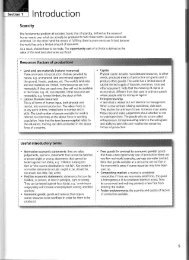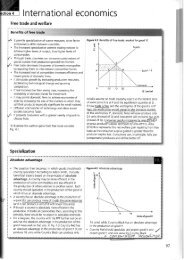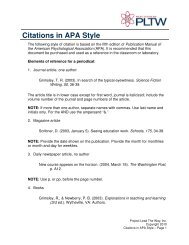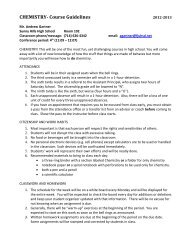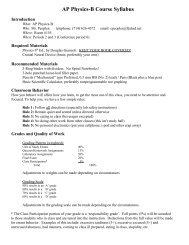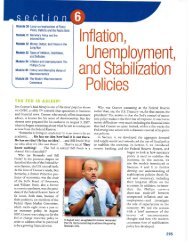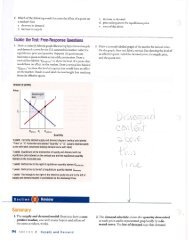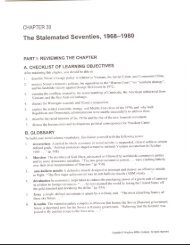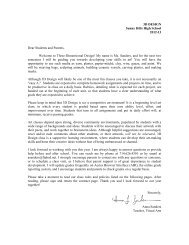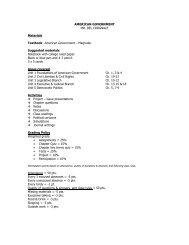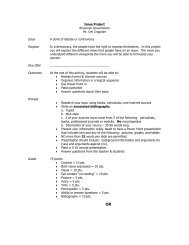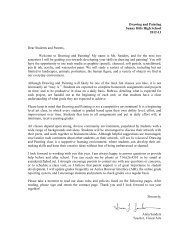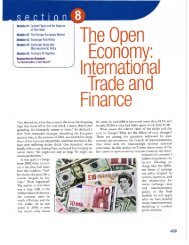IB Econ Chap 26 Terms of Trade - Sunny Hills High School
IB Econ Chap 26 Terms of Trade - Sunny Hills High School
IB Econ Chap 26 Terms of Trade - Sunny Hills High School
You also want an ePaper? Increase the reach of your titles
YUMPU automatically turns print PDFs into web optimized ePapers that Google loves.
l!!!!<br />
.E o<br />
fi co<br />
I<br />
c<br />
<strong>26</strong> o <strong>Terms</strong> <strong>of</strong> trade<br />
Student workpoint <strong>26</strong>.4<br />
Be an inquirer<br />
Using the following pr<strong>of</strong>ile based on information from<br />
The New Agriculturolisf and, doing a little bit <strong>of</strong> research<br />
on your own, answer the questions that follow.<br />
Focus on Benin<br />
One <strong>of</strong> Africa's<br />
strongest<br />
democracies,<br />
Benin, a country <strong>of</strong><br />
undulating plains<br />
and low mountain<br />
ranges, borders<br />
Nigeria, Niger,<br />
Togo, and Burkina<br />
Faso.<br />
Despite its strong<br />
democratic<br />
example, Benin's<br />
economic situation is less than healthy. Over half <strong>of</strong> the<br />
population rely on subsistence farming for their<br />
livelihood and the poor have not benefited from the<br />
country's legacies as the once-powerful kingdom <strong>of</strong><br />
Dahomey and, more recently, as one <strong>of</strong> Africa's largest<br />
cotton producers.<br />
Benin is heavily dependent upon trade with its<br />
neighbour Nigeria, leaving it vulnerable to that country's<br />
economic volatility. And, although Benin has privatized<br />
some <strong>of</strong> its national industry and encouraged foreign<br />
direct investment, it has recently been ranked among<br />
the poorest countries in the world in the United Nations<br />
Human Development lndex.<br />
The agricultural backbone<br />
Cotton is the only cash crop available to small-scale<br />
farmers, making up 400/0 <strong>of</strong> the country's CDP and over<br />
80o/o <strong>of</strong> export revenues. A consequence is that the<br />
Over half <strong>of</strong> Beninese are subsistence farrners<br />
country's fertile land has suffered environmental<br />
degradation as a result <strong>of</strong> the emphasis on production<br />
<strong>of</strong> cotton for the export market and because 9Oo/o <strong>of</strong> all<br />
pesticides are used on cotton. Heavy use <strong>of</strong><br />
agrochemicals has prompted widespread concern about<br />
the sustainability <strong>of</strong> the industry; this was particularly so<br />
between 1999 and 2000 following reintroduction <strong>of</strong><br />
the pesticide endosulfan, related to the banned DDT,<br />
which led to many farmers'deaths.<br />
The damage to both human health and the<br />
environment has prompted the widespread introduction<br />
<strong>of</strong> orSanic farming methods. Organic farming has almost<br />
doubled since 2003. Organizations, such as the<br />
Pesticide Action Netlvork based in the UK together with<br />
local partner OBEPAB (Organisation Beninoise pour la<br />
Promotion de lAgriculture Biologique), have trained<br />
local farmers-particularly women-in integrated pest<br />
management (lPM) and organic cotton farming through<br />
Farmer Field <strong>School</strong>s. IPM measures aimed at reducing<br />
chemical pesticide use to a minimum include improving<br />
soil fertilit/, recognizing disease, and encouraging<br />
natural enemies.<br />
Benin's export market has expanded to include other<br />
agricultural products. lhe production <strong>of</strong> shea nut butter,<br />
though more popular in Chana, is an activity now<br />
strongly associated with women and reported to be, at<br />
times, a more important source <strong>of</strong> income than cotton.<br />
Shea nuts are a staple in the local diet and their<br />
increasing use in the lucrative cosmetics industry is<br />
promoting interest in the export value <strong>of</strong> shea butter<br />
However, the process <strong>of</strong> making shea butter is laborious<br />
and in some seasons may be unpr<strong>of</strong>itable.<br />
Since the mid-l9B0s Benin has increased production <strong>of</strong><br />
yams, cassava, maize, peanuts, and pulses to achieve<br />
food security. Rice production, particularly <strong>of</strong> upland<br />
varieties Srown on dry land, has been boosted by the<br />
introduction <strong>of</strong> NERICA vadeties by the Africa Rice Center<br />
(VVARDA).'lhe new varieties combine the hardiness <strong>of</strong><br />
indigenous rice with the high yielding characteristics <strong>of</strong><br />
Asian varieties, and they are said to produce 500/0 more<br />
yield than local varieties without fertilizer use and up to<br />
200 more with fertilizer application.<br />
Although palm oil was a major cash crop in Benin during<br />
the l98os, its cultivation was marginalized by the<br />
popularity <strong>of</strong> cotton. But now, following the booming<br />
interest in bi<strong>of</strong>uels, palm oil production is increasingwhich<br />
has caused some controversy. 'The World<br />
Rainforest Movement has reported the allocation <strong>of</strong><br />
Deilveen JUOUOU and 4UUUOU hectares ot land tor<br />
palm oil produdion in humid southern Benin which,<br />
despite constituting only I Oo/o <strong>of</strong> national territory<br />
324 -o



